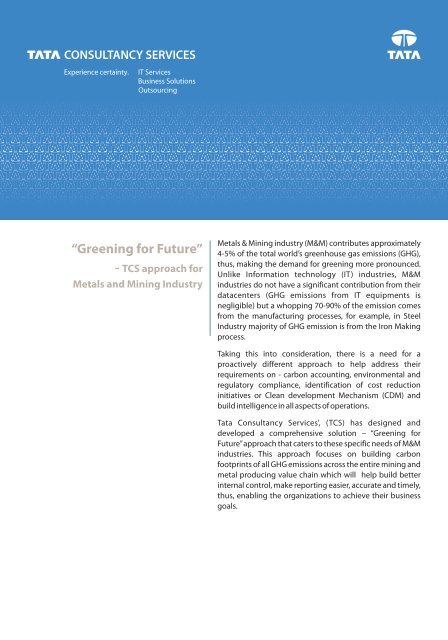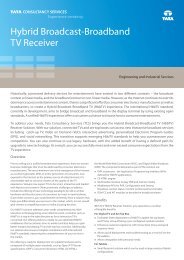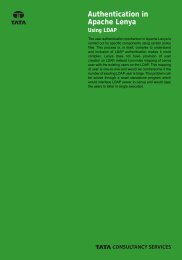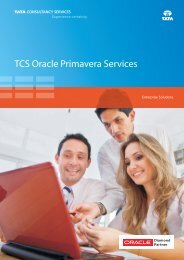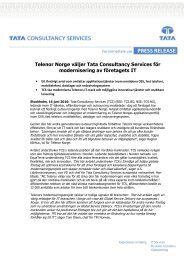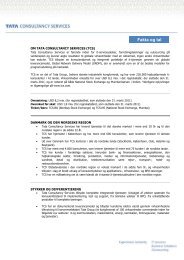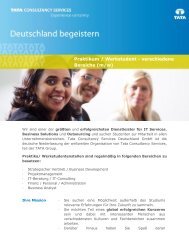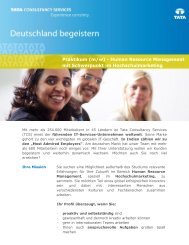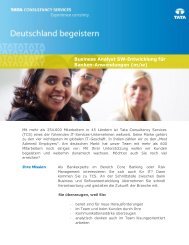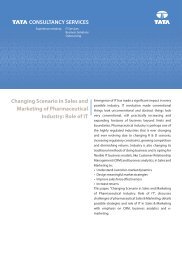Green Manufacturing - Tata Consultancy Services
Green Manufacturing - Tata Consultancy Services
Green Manufacturing - Tata Consultancy Services
Create successful ePaper yourself
Turn your PDF publications into a flip-book with our unique Google optimized e-Paper software.
“<strong>Green</strong>ing for Future”<br />
- TCS approach for<br />
Metals and Mining Industry<br />
Metals & Mining industry (M&M) contributes approximately<br />
4-5% of the total world’s greenhouse gas emissions (GHG),<br />
thus, making the demand for greening more pronounced.<br />
Unlike Information technology (IT) industries, M&M<br />
industries do not have a significant contribution from their<br />
datacenters (GHG emissions from IT equipments is<br />
negligible) but a whopping 70-90% of the emission comes<br />
from the manufacturing processes, for example, in Steel<br />
Industry majority of GHG emission is from the Iron Making<br />
process.<br />
Taking this into consideration, there is a need for a<br />
proactively different approach to help address their<br />
requirements on - carbon accounting, environmental and<br />
regulatory compliance, identification of cost reduction<br />
initiatives or Clean development Mechanism (CDM) and<br />
build intelligence in all aspects of operations.<br />
<strong>Tata</strong> <strong>Consultancy</strong> <strong>Services</strong>', (TCS) has designed and<br />
developed a comprehensive solution – “<strong>Green</strong>ing for<br />
Future” approach that caters to these specific needs of M&M<br />
industries. This approach focuses on building carbon<br />
footprints of all GHG emissions across the entire mining and<br />
metal producing value chain which will help build better<br />
internal control, make reporting easier, accurate and timely,<br />
thus, enabling the organizations to achieve their business<br />
goals.
1<br />
<strong>Green</strong>ing for Future - TCS approach for Metals and Mining Industry<br />
About the Author<br />
Sanjeev Ranjan<br />
As the Head of Growth Initiatives – Resources, ERU - ISU , he<br />
has more than 22 years of cross- functional and hands on<br />
experience in the areas of Business Strategy and<br />
Operationwith special focus on Business Process Analysis,<br />
Business Process Re-engineering, Operational Excellence,<br />
Project Management, Production Planning and Control,<br />
Marketing Strategy, OE sales, Branding and Building of<br />
Distribution Channel for retail sales, Benchmarking, New<br />
Product Introduction / Product Lifecycle Management ,<br />
Supply Chain Management – Strategic Sourcing, Six Sigma,<br />
TS 16949 auditor, Practitioner of TPM, Practitioner of Theory<br />
of Constraints, Managing teams including heading business<br />
functions.<br />
CSR Krishnan<br />
As the Global Sales and Delivery Head - IT infrastructure<br />
consulting, he has more than 17 years of experience in roles<br />
& responsibilities covering a wide range of architecture and<br />
technology areas including System software, Performance,<br />
Capacity and Availability management, Architecture<br />
solutions and System integration. He has worked<br />
extensively in locations across the globe - United States,<br />
Japan, United Kingdom, Switzerland, South Africa,<br />
Singapore and Sweden.<br />
Prashant Kumar<br />
As a team member in Growth Initiatives - Resources, ERU –<br />
ISU, he has more than 10 years of diverse experience in<br />
mining and metal industry across various functions such as<br />
Procurement, Operations, Maintenance, Marketing for a<br />
Steel Industry and has good knowledge in Post-M&A<br />
Integration, Strategic Sourcing, Procurement, Strategic<br />
Outsourcing, Value Chain Analysis, Knowledge<br />
Management, New product development, Benchmarking<br />
and industry analysis.
Table of Contents<br />
1. Introduction 3<br />
2. <strong>Green</strong> Business Drivers – IT View 3<br />
3. <strong>Green</strong> <strong>Manufacturing</strong> - Current Challenges 4<br />
4. Approach To <strong>Green</strong> <strong>Manufacturing</strong> 4<br />
5. <strong>Green</strong> Intelligence 6<br />
6. <strong>Green</strong> Logistics And Transportation 9<br />
7. <strong>Green</strong> IT 10<br />
8. <strong>Green</strong>ing Benefits 12<br />
9. Conclusion 12<br />
10. Reference 13<br />
2<br />
<strong>Green</strong>ing for Future - TCS approach for Metals and Mining Industry
Introduction<br />
The demand for greening of business practices has reached a tipping point. Each day we come across a new<br />
development, a corporate commitment, a technological breakthrough, a new partnership addressing<br />
environmental challenges, or a new finding from various agencies, labs or research groups about the progress being<br />
made. Amid the multitude developments there is progress, but it’s not always obvious or straightforward.<br />
Organizations are getting cleaner and more efficient, but only incrementally. Many of the gains are offset by the<br />
ever-growing economy. The greenhouse gas (GHG) emissions per dollar of economic activity may be dropping but<br />
the growing economy means that these emissions are largely unchanged. Moreover, there does exists a huge gap in<br />
the controls and measures which have been built in developed economies against those in developing economies.<br />
Mining and Metal Industry contributes to approximately 4-5% of the total world GHG emissions. Technological<br />
advancements in the industry over the past 25 years have enabled substantial reductions in CO2 emissions. Work is<br />
continuously on to build technologies that would radically reduce emissions and take the organizations to lower<br />
levels of GHG output.<br />
In this white paper, we will explain how TCS can help Mining and Metal Industry re-invent itself and act as a catalyst to<br />
achieve its vision of <strong>Green</strong> <strong>Manufacturing</strong> using strategic lever of IT coupled with a strong understanding of the<br />
business which focuses on three main areas –<br />
- <strong>Green</strong> Intelligence<br />
- <strong>Green</strong> Transportation and logistics, and<br />
- <strong>Green</strong> IT Consulting<br />
<strong>Green</strong> Business Drivers – IT View<br />
The change in attitude towards the environment among businesses is, no doubt, motivated in part by the same<br />
ethical concerns that preoccupy individuals. Yet it is also driven by a hard, practical reality. For organizations, the<br />
environmental impact of their activities represents a serious – and in some cases a massive risk. Environmental risk is<br />
viewed today in the same way as any other kind of risk. This has led to changes in the way businesses operate which<br />
makes it imperative for us to understand the key business drivers for the changed perception about environmental<br />
impact (Fig -1).<br />
<strong>Green</strong> Business Drivers<br />
A Profound Environment and Economic Change is Gathering Pace<br />
The drivers for <strong>Green</strong> initiatives<br />
comes from a variety of sources:<br />
�Government mandates<br />
�Energy efficiency<br />
�Product and company<br />
differentiation<br />
�Corporate Social Responsibility (CSR)<br />
�Corporate Sustainability<br />
3<br />
<strong>Green</strong>ing for Future - TCS approach for Metals and Mining Industry<br />
<strong>Green</strong> Regulations<br />
<strong>Green</strong> Consumers<br />
Investor Focus<br />
Executive View<br />
Business Initiatives<br />
Carbon Tax<br />
<strong>Green</strong> IT<br />
Voluntary<br />
Minority<br />
Growing<br />
Leading Edge<br />
Niche Projects<br />
None<br />
Interesting<br />
*Source: Forrester Research Inc. (Nov 2007)<br />
The Present The Future<br />
<strong>Green</strong> initiatives demonstrate the alignment & commitment of<br />
Corporate and business units towards protecting the environment.<br />
Fig 1<br />
Mandatory<br />
Majority<br />
Intense<br />
Mainstream<br />
Core to Business<br />
Multiple<br />
Required
<strong>Green</strong> <strong>Manufacturing</strong> - Current Challenges<br />
There is no denying of the fact that a greener company, with greener products and services, is more desirable to a<br />
growing segment of consumers and business customers. Because of the prominence of global warming concerns,<br />
going green has become part of any Corporate Social Responsibility (CSR) agenda to enhance customer and public<br />
perception. Some companies are led by “true believers” who simply want to do the right thing for the environment.<br />
To give prominence to the greening need, regulators in European Union (EU), United States (US), and elsewhere are<br />
aggressively monitoring this aspect of metal products and its related operations. This focuses on toxic materials<br />
used in building computing gear, disposal of electronic equipment, and emissions of CO2 and other greenhouse<br />
gases caused by energy / power consumption and other sources. Organizations have started believing that<br />
greening is not cost but it is a way of doing sustainable business – and this systematic thought has the potential to<br />
offer substantial cost reduction and in the process enhance the company’s competitive advantage.<br />
Global mining and metal production has been growing for the last 50 years. The steel industry, in particular, has<br />
grown to a production level of 1440 million mt in 2008 from a level of 200 million mt in 1950. The future growth in<br />
demand for steel will be driven mainly by the needs of the developing world which implies that the steel industry<br />
must continue to grow world wide by 3-5% and by 8-10% in China, India and Russia to satisfy these needs. The same<br />
logic also applies to other metal industries. But with this growth comes the increase in significant amount of GHG<br />
emissions.<br />
Unlike IT industries, metal industries do not have significant spend on datacenters, but their manufacturing process<br />
itself emits huge amount of GHG emissions. According to the Intergovernmental Panel on Climate Change (IPCC),<br />
the steel industry accounts for between 4-5% of total world greenhouse gas emissions. On average, 1.7 tonnes of<br />
carbon dioxide are emitted for every tonne of steel produced. Another important aspect of metal industry is that<br />
approximately 90% of the emissions in the steel industry comes from Iron Making and about 60 - 70% of the<br />
emission in Aluminium industry comes from smelting operations, whereas the same from IT equipments is<br />
negligible.<br />
Approach to <strong>Green</strong> <strong>Manufacturing</strong><br />
In M&M Industries, the journey to climate neutrality is not a straight line, but a cycle, a matter of slimming down the<br />
GHGs that are within our responsibility and offsetting the remainder. Secondly, <strong>Green</strong> <strong>Manufacturing</strong> in Metal<br />
Industry is not only about datacenters but about GHG emissions across the entire metal producing value chain.<br />
Therefore, TCS defines its <strong>Green</strong> <strong>Manufacturing</strong> capability under three dimensions – <strong>Green</strong> Intelligence, <strong>Green</strong><br />
Transportation and Logisctis and <strong>Green</strong> IT Consulting.I It collectively attempts to cover the entire value chain with<br />
focus on how to make it green and lean using the Supply Chain Organisation’s (SCOR) model . This helps us to<br />
identify and minimize the “bad inputs and outputs” and maximize on the “Good outputs” (Fig -2 )<br />
4<br />
<strong>Green</strong>ing for Future - TCS approach for Metals and Mining Industry
Inputs<br />
Impacts<br />
Energy<br />
Water<br />
Mine<br />
� Production<br />
Planning<br />
� Contract &<br />
Non-contract<br />
mines<br />
� Fleet<br />
Management<br />
Mining & Ore Dressing<br />
<strong>Green</strong> SCOR Model<br />
�<strong>Green</strong> Intelligence – It facilitates carbon accounting across the metal producing value chain using green<br />
intelligence, which helps to capture this information and use it for better control and future development of<br />
Clean Development Mechanisms (CDM) Projects. The Carbon Emissions Management System (CEMS)<br />
framework developed in house helps to standardize and improve processes, provide single platform to manage<br />
environmental compliance, consistently supply emission data for carbon credits trading, and strategically link<br />
carbon accounting into company’s risk management framework. <strong>Green</strong> Transportation and Logistics – In the<br />
M&M industry, bulk of material is transported either through road, rail or sea. TCS <strong>Green</strong> Consultants help to<br />
make these operations greener and leaner by better scheduling and utilization of the fleet of mobile<br />
equipments leading to recurring savings which are then re-invested in maintaining the upkeep of the<br />
equipments.<br />
�<strong>Green</strong> IT Consulting – It looks after greening efforts focused at IT operations where TCS <strong>Green</strong> IT consultants<br />
helps customers align their IT vision and strategy with their business and sustainability goals to achieve superior<br />
performance. By improving the IT infrastructure and capabilities that affect people and processes across the<br />
organization, we can help our clients use IT to reduce their carbon footprint while increasing efficiency and<br />
productivity. The result is immediate environmental and business benefits, reduced costs and maximized value<br />
of our client’s IT spends.<br />
5<br />
<strong>Green</strong>ing for Future - TCS approach for Metals and Mining Industry<br />
Energy<br />
Energy Energy<br />
Minimize the “bad” inputs and outputs<br />
Raw<br />
Water Materials Water Water<br />
Energy Energy $ Energy<br />
Ore<br />
Processing<br />
� Scheduling &<br />
Tracking<br />
� Resource<br />
Blending<br />
� Inventory<br />
Management<br />
Air<br />
Water<br />
Waste<br />
Steel Processing & Finishing Transportation, Marketing & Distribution<br />
Metal<br />
Processing<br />
� Operations<br />
Scheduling<br />
� Production<br />
Recording<br />
� Downtime<br />
Tracking<br />
� Quality<br />
Air<br />
Water<br />
Waste<br />
Product<br />
System View of Environmental Lifecycle<br />
Integrated Product Policy – Lifecycle Assessment (LCA)<br />
Casting<br />
&<br />
Finishing<br />
� Scheduling &<br />
Tracking<br />
� Quality<br />
� Inventory<br />
Management<br />
Air<br />
Water<br />
Waste<br />
Fig 2<br />
Waste<br />
Rail Port Customer<br />
� Transport<br />
scheduling &<br />
Tracking<br />
� Train Loading<br />
� Inventory<br />
Management<br />
� Material<br />
Movement<br />
�Inventory<br />
Management<br />
�Berth<br />
Scheduling<br />
�Quality<br />
Air Air<br />
Water<br />
Air<br />
Water<br />
Waste<br />
Disposal<br />
� Invoice &<br />
Payments<br />
�Stock<br />
Movements<br />
�Inventory<br />
Management<br />
�Quality<br />
Minimize the “bad” inputs and outputs<br />
$
<strong>Green</strong> Intelligence<br />
<strong>Green</strong> Intelligence facilitates carbon accounting across the metal producing value chain which helps to capture this<br />
information and use it for better control and future development. The ‘Carbon Emission Management System’<br />
(CEMS) framework helps to understand various <strong>Green</strong>ing opportunities starting from input raw material, utilization<br />
of energy, air or water to the final product. It also cuts through various by-products, waste generated during the<br />
process. All these steps together help to understand the key industry GHG drivers (Fig – 3).<br />
Industry<br />
Expertise<br />
Best<br />
Practices<br />
TCS’<br />
Assets<br />
TM<br />
Global Networked Delivery Model Experience Certainty<br />
Performance Levers<br />
Process<br />
Mapping<br />
� Mapping<br />
<strong>Manufacturing</strong><br />
Processes<br />
� Capturing<br />
Emission data<br />
� Recording<br />
Process KPI's<br />
� Capturing<br />
Asset<br />
Performance<br />
Business & Technology<br />
Innovation<br />
Carbon Emissions Management<br />
Emissions Data<br />
Compilation<br />
� Identify and<br />
define data<br />
parameters<br />
� Define rules<br />
for estimating<br />
emission data<br />
Additionally, real-time data is captured for all GHG contributing process parameters – such as in a Steel Industry GHG<br />
is captured for iron making (blast furnace, coke making, sinter making), steel making, hot rolling and cold rolling. The<br />
rigor of the TCS data capturing can be assessed from the fact that data is captured from micro level<br />
process/equipment/PLCs/shop-floor systems of the manufacturing process, for example, in case of blast furnace,<br />
data is captured from direct production process, flaring of gases, electricity and fuel consumed and other such parts<br />
of the process. These are further drilled down to micro level sources. Once the data sources from micro to macro level<br />
are systematically established, TCS helps create real-time role-based visibility of GHG emission drivers.<br />
The screen shots given below(Fig 4-6) show how we can view this information at various levels of the enterprise and<br />
help track the relevant Key Performance Indicators (KPIs). This enables the key stakeholders to monitor progress,<br />
identify opportunities and take decisions .<br />
6<br />
<strong>Green</strong>ing for Future - TCS approach for Metals and Mining Industry<br />
Compliance<br />
Requirements<br />
� Study impact<br />
of compliance<br />
requirements<br />
� Validate<br />
emission data<br />
set<br />
� Assign<br />
emission<br />
allowances to<br />
individual<br />
assets<br />
Define Analyze Verify<br />
Value Drivers<br />
Process Excellence<br />
(PEM)<br />
Fig 3<br />
Reporting<br />
� Establish<br />
Reporting<br />
requirements<br />
� Define control/<br />
change<br />
requirements<br />
� Build<br />
dashboard<br />
view<br />
Build<br />
Enablers<br />
Quality Management<br />
Systems (iQMS)<br />
Alliances<br />
&<br />
Partnerships<br />
Centers<br />
Of<br />
Excellence<br />
Values<br />
&<br />
Standards
Coal<br />
Iron Ore<br />
Lime stone<br />
Home<br />
Site Compliance<br />
Reference<br />
Measurement Data<br />
Calculations<br />
Reporting<br />
Operation Report<br />
Project Report<br />
Business Report<br />
Audit Report<br />
Administration<br />
Manage Users<br />
Coke<br />
ovens<br />
Sinter<br />
plants<br />
Lime<br />
kilns<br />
20%<br />
Iron making<br />
(Co 91%)<br />
2<br />
Blast<br />
furnace<br />
Steel making<br />
(1%)<br />
Converter<br />
30%<br />
50%<br />
Blast Furnace Coke Plant Sinter Plant<br />
Resource CO2 emissions<br />
Coke 43%<br />
Coal injected into blast furnace 20%<br />
Limestone 5%<br />
Dolomite 2%<br />
Coke oven byproduct A 10%<br />
Coke oven byproduct B 5%<br />
Coke oven gas 5%<br />
Charcoal 10%<br />
Carbon Emission (YTD)- Plan<br />
Project Implementation Status<br />
Fig 4<br />
Real-time visibility – Enterprise Level<br />
Carbon Emission Management System > Enterprise<br />
Refining Smelting Casting<br />
Carbon Emission (YTD)-Actual<br />
<strong>Green</strong> Intelligence for Metal Industry<br />
Hot rolling<br />
(4%)<br />
Hot rolling<br />
mills<br />
Hot<br />
rolling<br />
300 MT<br />
288 MT<br />
85.7%<br />
Fig 5<br />
7<br />
<strong>Green</strong>ing for Future - TCS approach for Metals and Mining Industry<br />
Process Source of emission<br />
Blast Furnance Direct Production Process<br />
Source Fueltype<br />
BF D DG Station LDO<br />
Furnace Oil<br />
Cold<br />
rolling<br />
Cold rolling<br />
(3%)<br />
Cold rolling<br />
mills<br />
5%<br />
mTof f CO2 C 2<br />
10%<br />
Steel<br />
products<br />
500<br />
450<br />
400<br />
350<br />
300<br />
250<br />
200<br />
150<br />
100<br />
50<br />
0<br />
Carbon Emissions Trend<br />
Apr<br />
-0 8<br />
May-08<br />
Jun-0 8<br />
Jul-08<br />
Aug-08<br />
Sep-08<br />
Oct-08<br />
Nov-0 8<br />
Dec-08<br />
Jan-0 9<br />
Feb-09<br />
Forecast<br />
Co 2<br />
36.5<br />
emissions (MtCO )<br />
2<br />
16.2<br />
Flaring of Gas<br />
Fuel consumed in Equipments<br />
Electricity consumed in Equipments<br />
Transportation<br />
Office space<br />
Source Co2 emission in metric tons<br />
Skip Car Electricity<br />
Drilling machine Electricity<br />
Mud Gun Electricity<br />
Oxygen Own<br />
Oxygen Purchase<br />
CO<br />
2<br />
emissions<br />
CO2- MT<br />
62.0<br />
28.9 30.2 30.5<br />
Crude steel production (Mt-S)<br />
Co2intensity (tCO 2/t-crude<br />
steel)<br />
2.25<br />
2.15<br />
2.09 2.06<br />
% CO 2 Emissions<br />
9%<br />
10%<br />
66%<br />
Ch 4<br />
emissions<br />
63.1 62.8<br />
1990 2003 2004 2005<br />
Mar-09<br />
N O<br />
2<br />
emissions<br />
Refining<br />
Smelting<br />
Remelting<br />
Hot Rolling<br />
Cold Rolling
Smelting<br />
Process Diagram<br />
Measurement Data<br />
Calculations<br />
New Projects<br />
Project Status<br />
Power Consumption<br />
Fuel Consumption<br />
Anode Consumption<br />
8%<br />
Tonne of CO C O 2 / mT<br />
of Hot metal<br />
7%<br />
Real-time visibility – Process Group Level<br />
Carbon Emission Management System > Enterprise<br />
> Smelting<br />
Specific GHG Emission Emission- - Smelting<br />
3<br />
2.5<br />
2<br />
1.5<br />
1<br />
0.5<br />
0<br />
Apr- May- Jun- Jul- Aug- Sep- Oct- Nov-<br />
08 08 08 08 08 08 08 08<br />
Month<br />
25%<br />
25%<br />
Electricity<br />
Natural Gas<br />
8%<br />
Fuel & Oil<br />
60%<br />
Fig 6<br />
8<br />
<strong>Green</strong>ing for Future - TCS approach for Metals and Mining Industry<br />
Plan<br />
Actual<br />
Carbon Anode<br />
Smelting<br />
Smelting<br />
Emission Reduction Project Status-<br />
Smelting<br />
Emission Proportion–Smelting Proportion-Smelting Emission Emission Reduction Reduction Project Project Status Status- Smelting - Smelting<br />
N o.s<br />
60<br />
50<br />
40<br />
30<br />
20<br />
10<br />
0<br />
Apr-<br />
08<br />
Jun-<br />
08<br />
Aug-<br />
08<br />
Oct-<br />
08<br />
Dec-<br />
08<br />
Cumm. Identified<br />
Plan Cumm<br />
Feb-<br />
09
<strong>Green</strong> Logistics and Transportation<br />
9<br />
<strong>Green</strong>ing for Future - TCS approach for Metals and Mining Industry<br />
In a scenario of rising energy and fuel costs and tougher regulations on carbon footprint it is important for M&M<br />
industry to focus on greening and leaning of their transportation and logistics (T&L) management services. The<br />
requirement is to understand appropriate optimization and greening techniques for various aspects of T&L such as<br />
fleet management and transport tracking, usage based insurance, toll collection, emissions calculation and other<br />
such aspects (Fig – 7).<br />
TCS offers specific services in:<br />
�Network Planning<br />
�Transport optimization<br />
�Route optimization<br />
�In-plant vehicle scheduling and optimization<br />
�High performance mobile asset management<br />
�Workforce optimization<br />
Integrated <strong>Green</strong> Logistics and Transportation<br />
Mine<br />
� Excavation<br />
Operation<br />
� Extracted ore<br />
transfer to<br />
storage yard<br />
� Extracted ore<br />
dispatch for<br />
processing<br />
Ore<br />
Processing<br />
�<br />
Asset<br />
Management<br />
�High<br />
performance<br />
mobile asset<br />
management<br />
processed<br />
ore to metal<br />
processing/<br />
customer<br />
Metal<br />
Processing<br />
Casting<br />
&<br />
Finishing<br />
Key Logistics operations across the value chain<br />
Dispatch of � Raw material receipt/ transportation<br />
�<br />
- Coke transportation<br />
- Sinter/ Pallet transportation<br />
- Lime stone transportation<br />
- Ore transportation<br />
� Primary metal/ semi finished metal transportation<br />
- Hot metal transportation<br />
- Slabs/ HRC transportation<br />
� Finished product storage and transportation<br />
� Indirect material storage and transportation<br />
Process<br />
Management<br />
People<br />
Management<br />
TCS Focus - <strong>Green</strong> Logistics and Transportation Solution Areas<br />
Network Design<br />
Route optimisation<br />
and scheduling –<br />
Railways, roadways,<br />
shipping lines<br />
Logistics and Transportation<br />
<strong>Green</strong> Enablement Categories<br />
Transport<br />
optimization<br />
Dock management<br />
�<br />
Fig 7<br />
Rail Port Customer<br />
�Workforce<br />
optimization<br />
Technology<br />
Management<br />
�<br />
�Return<br />
load<br />
transportation<br />
Supply chain visibility<br />
and collaboration<br />
technologies<br />
Vehicle Telematics<br />
Disposal
<strong>Green</strong> IT<br />
10<br />
<strong>Green</strong>ing for Future - TCS approach for Metals and Mining Industry<br />
An understanding of the <strong>Green</strong> IT challenges (Fig - 8) has prompted TCS <strong>Green</strong> IT consultants to come up with an<br />
Inclusive Approach using a framework that aims at building <strong>Green</strong> Index capabilities for promoting greening of IT<br />
operations to achieve organization’s sustainability goals.<br />
The three key steps are explained below.<br />
Fig 8<br />
STEP 1: Setting up of <strong>Green</strong> Agenda: This forms the basis of establishing opportunities for <strong>Green</strong>ing in the<br />
organization. This step helps to build the action levers which can provide tremendous opportunities for reducing<br />
the year-on-year cost and carbon content along with improving Compliance, CSR, Branding, Asset Utilization and<br />
Governance.<br />
STEP 2: Building of Inclusive approach to <strong>Green</strong>: This looks at the three components – determining the optimization<br />
potential, building of design solution and developing of solution roadmap and implementation (Fig – 9).<br />
STEP 3: Building of <strong>Green</strong> Index: This provides the visibility to a metric driven organization and can be built into the<br />
Balance Score Card (BSC) at different level to reflect the progress (Fig –10).
Key <strong>Green</strong> Metrics<br />
Fig 9<br />
Fig 10<br />
Corporate executives expect both financial and public relations payback, with green being an important<br />
competitive advantage while not serving as a cost burden. These business drivers have led to a considerable buzz<br />
around <strong>Green</strong> IT.<br />
11<br />
<strong>Green</strong>ing for Future - TCS approach for Metals and Mining Industry<br />
<strong>Green</strong> Index 3.4<br />
This<br />
Month<br />
Last<br />
Month<br />
Change Total
<strong>Green</strong>ing Benefits<br />
The systematic process conceptualized by TCS can help clients to optimize the energy requirements which can then<br />
be ploughed back into various greening initiatives as new investments. Some of the benefits of greening are listed<br />
below:<br />
�Information sharing<br />
�Empowers organizations with new detailed eco-knowledge and corresponding indicators of performance<br />
�Controls and reduces material waste in manufacturing cycles<br />
�Preserves capital and saves money<br />
�Improves productivity and increases cost savings<br />
�Helps drive and influence corporate behavior both internal and external to ensure sustainability<br />
�Encourages innovation in conducting business internally and interfaces with the rest of the world<br />
�Easy adaptibity to changing rules in environmental regulations and legislation<br />
�Helps realise Triple Bottom Line (TBL)-for measuring an organisation’s commitment and conformance to various<br />
economic, societal, and environmental factors<br />
Conclusion<br />
TCS ‘<strong>Green</strong> <strong>Manufacturing</strong>’ approach to help the Metal Industry align their IT vision with their Organizational Vision.<br />
Thus, helping them achieve their sustainability goals.<br />
By improving the IT infrastructure and carbon emissions that affect people and processes across the organization,<br />
TCS helps our clients use IT to reduce their carbon footprint while increasing efficiency and productivity. The result is<br />
immediate environmental and business benefits, reduced costs and maximized value. A technology driven<br />
transformation of the Metal Industry will shape a powerful and positive future – a future that ensures a competitive,<br />
a secure supply of metals and a sustainable environment.<br />
12<br />
<strong>Green</strong>ing for Future - TCS approach for Metals and Mining Industry
Reference<br />
�Kick the habit UN paper<br />
�The need for a global sector approach to CO2 emissions reduction for the steel industry Ian Christmas,<br />
IISI Secretary General<br />
�Make IT <strong>Green</strong> – TCS way<br />
�TCS CorporateSustainability Report, 2007.<br />
http://www.tcs.com/about/corp_responsibility/Documents/TCS_Corporate%20_Sustainability_Report_2007<br />
_Fi nal.pdf<br />
�ISO 14000 Essentials. International Organization for Standardization.<br />
http://www.iso.org/iso/iso_14000_essentials<br />
�The Leadership in Energy and Environmental Design (LEED) <strong>Green</strong> Building Rating System. U.S. <strong>Green</strong><br />
Building Council.<br />
http://www.usgbc.org/DisplayPage.aspx?CMSPageID=222<br />
�ENERGY STAR for Computers. U.S. Environmental Protection Agency.<br />
http://www.energystar.gov/index.cfm?fuseaction=find_a_product.showProductGroup&pgw_code=CO<br />
�Product and Supply Chain Standard. The <strong>Green</strong>house Gas Protocol Initiative.<br />
http://www.ghgprotocol.org/standards/product-and-supply-chain-standard/<br />
�B. Sood, The CIO’s Role in Enterprise-wide Environmental Responsibility, Gartner Briefing, Mumbai, July 2008<br />
�State of green business 2008 - Joel Makower from www.greenbiz.com<br />
�<strong>Green</strong> IT a Natural Fit for Enterprise Executives, IDC Press Release, October 2007.<br />
http://www.idc.com/getdoc.jsp?containerId=prUS20932407<br />
�The <strong>Green</strong>house Gas Protocol Initiative. http://www.ghgprotocol.org/<br />
�J. G. Koomey, Estimating Total Power Consumption by Servers in the U.S. and the World, February 2007.<br />
http://enterprise.amd.com/Downloads/svrpwrusecompletefinal.pdf<br />
�T. Schudi et al. High Performance Data Centers: A Research Roadmap. Lawrence Berkeley National<br />
Laboratory. http://hightech.lbl.gov/documents/DataCenters_Roadmap_Final.pdf<br />
�Data Centers: Annotated Bibliography.<br />
http://hightech.lbl.gov/dc-bibliography.html<br />
�Manufacturer’s Association for Information Technology, 2008.<br />
http://www.business--standard.com/india/storypage.php?tp=on&autono=42371<br />
13<br />
<strong>Green</strong>ing for Future - TCS approach for Metals and Mining Industry
Subscribe to TCS White Papers<br />
TCS.com RSS: http://www.tcs.com/rss_feeds/Pages/feed.aspx?f=w<br />
Feedburner: http://feeds2.feedburner.com/tcswhitepapers<br />
www.tcs.com<br />
About <strong>Tata</strong> <strong>Consultancy</strong> <strong>Services</strong> (TCS)<br />
<strong>Tata</strong> <strong>Consultancy</strong> <strong>Services</strong> Limited is an IT services, business solutions<br />
and outsourcing organization that delivers real results to global<br />
businesses, ensuring a level of certainty no other firm can match. TCS<br />
offers a consulting-led, integrated portfolio of IT and IT-enabled<br />
services delivered through its unique Global Network Delivery<br />
TM<br />
Model , recognized as the benchmark of excellence in software<br />
development.<br />
A part of the <strong>Tata</strong> Group, India's largest industrial conglomerate, TCS<br />
has over 100,000 of the world's best trained IT consultants in 50<br />
countries. The company generated consolidated revenues of US<br />
$5.7billion for fiscal year ended 31 March 2008 and is listed on the<br />
National Stock Exchange and Bombay Stock Exchange in India. For<br />
more information, visit us at www.tcs.com<br />
eru.pmo@tcs.com<br />
All content / information present here is the exclusive property of <strong>Tata</strong> <strong>Consultancy</strong> <strong>Services</strong> Limited<br />
(TCS). The content / information contained here is correct at the time of publishing.<br />
No material from here may be copied, modified, reproduced, republished, uploaded, transmitted,<br />
posted or distributed in any form without prior written permission from TCS. Unauthorized use of the<br />
content / information appearing here may violate copyright, trademark and other applicable laws, and<br />
could result in criminal or civil penalties.<br />
Copyright © 2009 <strong>Tata</strong> <strong>Consultancy</strong> <strong>Services</strong> Limited


